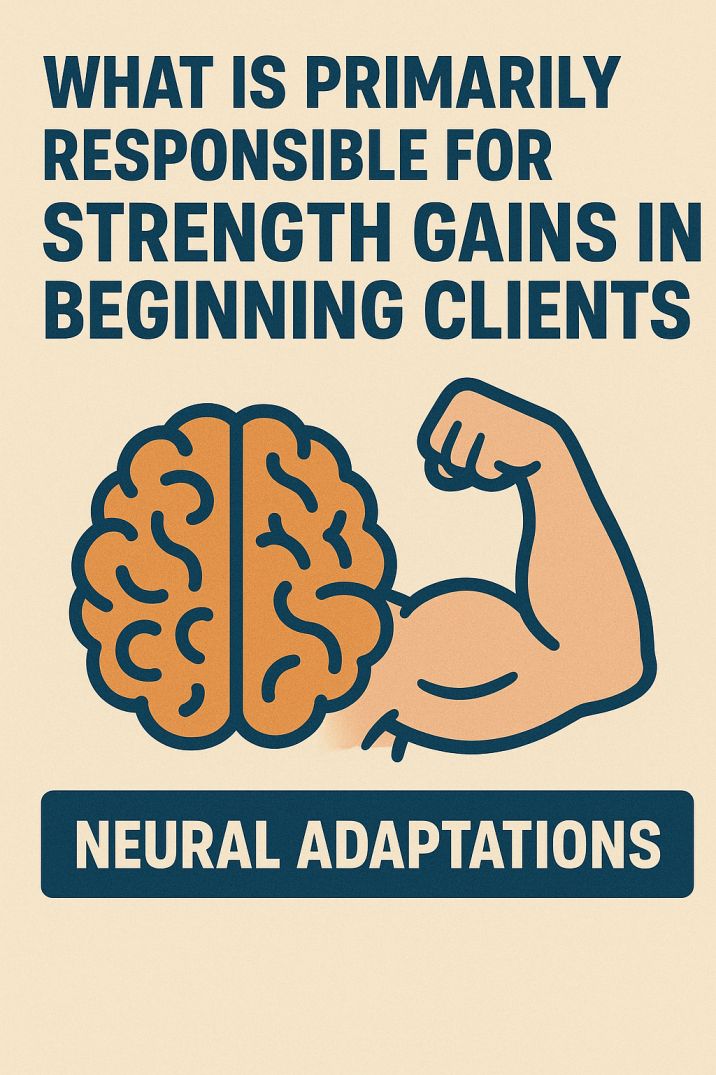What is primarily responsible for strength gains in beginning clients
When new clients get started with strength training, they often experience quick results within the first few weeks. But what is primarily responsible for strength gains for beginning clients? Despite popular belief, it’s not just about muscle growth. Instead, early strength improvements come from neuromuscular adaptations—a process in which the nervous system becomes more efficient at using existing muscles.
Online Assignment Helper provides expert-written content and assignment help in fitness science, fitness therapy, sports study, and more.
Neuromuscular Adaptations: The Key Factor what is primarily responsible for strength gains in beginning clients
In the early stages of strength training, the body undergoes changes in how the brain and muscles communicate. This phenomenon is known as neuromuscular adaptation. Here’s how it works:
✅ Improved Motor Unit Recruitment
The nervous system learns to activate more muscle fibers during lifts, making movements stronger and more controlled.
✅ Enhanced Coordination
Beginners improve movement patterns, reducing energy waste and boosting efficiency.
✅ Increased Firing Rate
The speed and frequency of muscle fiber activation increase, leading to more explosive strength.
✅ Reduced Neural Inhibition
The brain becomes more confident in allowing muscles to exert force without fear of injury.
Better Timing and Synchronization:
Multiple muscles start firing in better harmony. Movements feel smoother, stronger, and more controlled.
Why it’s Not Hypertrophy at First
Muscle hypertrophy (actual muscle size increase) takes a longer time to develop. In the first 4–6 weeks, most strength gains come down to the nervous system adaptation-not to visible muscle growth. While hypertrophy plays a major role later, it’s not the primary reason for early gains.
Other Supporting Factors in Beginners’ Strength Gains
- 🏋️️ Consistent Progressive Overload
- 🥗 Improved Nutrition and Recovery
- 🧠 Increased Mind-Muscle Connection
- 🧘 Better Muscle Activation Through Focused Technique
Application in Training Programs
For fitness coaches, understanding these initial changes is crucial. Beginner clients benefit most from:
- Full-body workouts
- Basic compound lifts
- Low to moderate volume with controlled form
- Frequent practice for movement mastery
Muscle Growth vs. Strength Gains
- While muscle hypertrophy is significant, it takes weeks or even months to have a significant impact on strength. Most beginners see early strength improvements before their muscle size increases. This is because:
- Neural efficiency improves first.
- Muscle mass increases later through protein synthesis.
- Beginners can lift more without looking significantly bigger at first.
Key Scientific Evidence
Studies in exercise physiology reveal that up to 90% of early strength gains (first 4–6 weeks) can be attributed to neural improvements, including:
- Increased neural drive
- Enhanced agonist muscle activation
- Reduced antagonist muscle co-contraction
Source: NSCA – National Strength and Conditioning Association
Real-World Example
A beginner starts bench pressing 40 lbs. In three weeks, they may lift 70 lbs, but their chest may not look wider. This is because their body has learned how to recruit more muscle fibers efficiently, but has not grown more muscle yet.
Adaptation Timeline for Beginners
| Week | Key Changes |
| 1–2 | Neural learning, improved form, reduced hesitation |
| 3–4 | Enhanced motor unit recruitment, better balance |
| 5–6 | Noticeable strength gains without size change |
| 7–10 | Gradual hypertrophy begins, strength keeps increasing |
Training Tips for Maximizing Beginner Strength Gains
✅ Focus on Technique
Perfect your form before lifting heavy. Proper technique enhances neuromuscular learning.
✅ Use Compound Movements
Squats, deadlifts, presses, and rows recruit multiple muscle groups and train the nervous system efficiently.
✅ Progressive Overload
Gradually increase weights or reps each week to keep challenging your nervous system.
✅ Keep Volume Moderate
Too much volume can lead to fatigue. Beginners respond best to 3–4 sessions/week.
Assignment Help on Exercise Science Topics
Are you a student working on:
- 🧪 Sports Science Assignments
- 🏃♂️ Strength Training Research
- 📝 Neuromuscular Physiology Essays
- 📊 Kinesiology Lab Reports
Let Online Assignment Helper assist you with expertly written, plagiarism-free academic help!
📌 Why Choose Us?
✅ PhD-qualified Exercise Science Writers
✅ On-Time Delivery with Proofreading
✅ 24/7 Support & Custom Writing Options
✅ Fitness Theory + Real-World Application Combined
➡️ Get help now: assignment helper
Need Help with Sports Science or Fitness Assignments?
Whether you’re studying exercise physiology, personal training certification, or sports biomechanics, our academic experts can help you write:
- 📚 Fitness & Health Essays
- 📈 Strength Training Reports
- 🧪 Exercise Science Case Studies
- ✅ Kinesiology Research Papers
Visit online assignment help and get top-rated fitness science assignment help today!
Conclusion
So, what is primarily responsible for strength gains in beginning clients? The answer lies in the nervous system’s adaptability—not just in growing bigger muscles. Understanding this helps trainers, students, and athletes design smarter programs with realistic expectations and better early results.


Leave your comment